Mpumalanga
Mpumalanga
Mpumalanga iMpumalanga (in Swazi and Zulu) IMpumalanga (in Southern Ndebele) | |
|---|---|
| | |
| Motto(s): Omnia labor vincit (Labour will conquer all) | |
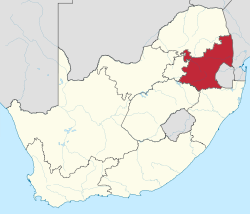 Location of Mpumalanga in South Africa | |
| Country | South Africa |
| Established | 27 April 1994 |
| Capital | Mbombela |
| Districts | |
| Government | |
| • Type | Parliamentary system |
| • Premier | Refilwe Mtsweni-Tsipane (ANC) |
| • Legislature | Mpumalanga Provincial Legislature |
| Area [1]:9 | |
| • Total | 76,495 km2 (29,535 sq mi) |
| Area rank | 8th in South Africa |
| Highest elevation | 2,331 m (7,648 ft) |
| Population | |
| • Total | 4,039,939 |
| • Estimate (2020) | 4,679,786 |
| • Rank | 6th in South Africa |
| • Density | 53/km2 (140/sq mi) |
| • Density rank | 3rd in South Africa |
| Population groups [1]:21 | |
| • Black | 90.7% |
| • White | 7.5% |
| • Coloured | 0.9% |
| • Indian or Asian | 0.7% |
| Languages [1]:25 | |
| • Swazi | 27.7% |
| • Zulu | 24.1% |
| • Tsonga | 10.4% |
| • Southern Ndebele | 10.1% |
| • Pedi | 9.3% |
| • Afrikaans | 7.2% |
| • Southern Sotho | 3.5% |
| • English | 3.1% |
| Time zone | UTC+2 (SAST) |
| ISO 3166 code | ZA-MP |
| HDI (2018) | 0.673[3] medium · 7th |
| Website | www |
Mpumalanga (/əmˌpuːməˈlɑːŋɡə/) is a province of South Africa. The name means "east", or literally "the place where the sun rises" in the Swazi, Xhosa, Ndebele and Zulu languages. Mpumalanga lies in eastern South Africa, bordering Eswatini and Mozambique. It constitutes 6.5% of South Africa's land area. It shares borders with the South African provinces of Limpopo to the north, Gauteng to the west, the Free State to the southwest, and KwaZulu-Natal to the south. The capital is Mbombela.[4]
History[edit]
Before 1994, Mpumalanga was part of the now-defunct Transvaal Province. The province's name was Eastern Transvaal, from its initial establishment in 1994 until 24 August 1995. Prior to the establishment of the province, the term "Eastern Transvaal" was used to refer to the eastern part of Transvaal Province, or to the scenic tourist area around the Escarpment and Mpumalanga Lowveld bordering the Kruger National Park.
Mpumalanga has a rich archaeological heritage. Dotting the landscape are distinctive Bokoni stone-walled sites, built by a precolonial agropastoral society between ~1500 and 1820 A.D.[5][6]
Geography[edit]
The Drakensberg escarpment divides Mpumalanga into a westerly half consisting mainly of high-altitude grassland called the Highveld and an eastern half situated in low-altitude subtropical Lowveld/Bushveld, mostly savanna habitat. The southern half of the Kruger National Park is in the latter region. The Drakensberg exceeds heights of 2000 m in most places, with this central region of Mpumalanga being very mountainous. These regions have alpine grasslands and small pockets of Afromontane forest. The Lowveld is relatively flat with interspersed rocky outcrops. The Lebombo Mountains form a low range in the far east, on the border with Mozambique.
Some of the oldest rocks on earth have been found in the Barberton area; these ancient greenstones and metamorphosed granites form the Crocodile River Mountains in the southeast of the province. The Lowveld is underlaid by African Cratonic Basement rocks of ages in excess of 2 billion years. The Highveld is mostly Karoo Sequence sedimentary rock of a younger, Carboniferous to Permian age.
Mpumalanga is the only South African province to border two provinces of Mozambique (Gaza Province to the northeast and Maputo Province to the east), as well as all four regions of Eswatini (Lubombo, Hhohho, Manzini, and Shiselweni Districts).
Climate[edit]
The Lowveld is subtropical, due to its latitude and proximity to the warm Indian Ocean. The Highveld is comparatively much cooler, due to its altitude of 2300 m to 1700 m above sea level. The Drakensberg escarpment receives the most precipitation, with all other areas being moderately well-watered by mostly summer thunderstorms. The Highveld often experiences severe frost, while the Lowveld is mostly frost-free. Winter rainfall is rare, except for some drizzle on the escarpment. The differences in climate are demonstrated below by the capital, Mbombela, which is in the Lowveld, an hour from Belfast on the Highveld.
- Mbombela averages: January maximum: 29 °C (min: 19 °C), July maximum: 23 °C (min: 6 °C), annual precipitation: 767 mm
- Belfast averages: January maximum: 23 °C (min: 12 °C), June maximum: 15 °C (min: 1 °C), annual precipitation: 878 mm
Fauna and flora[edit]
The diverse and special flora and fauna of the province enjoys protection in a range of nature reserves, including:
- Blyde River Canyon Nature Reserve
- Great Limpopo Transfrontier Park, previously known as Gaza-Kruger-Gonarezhou Transfrontier Park. This international game park brings together some of the best and most established wildlife areas in southern Africa. The park is managed as an integrated unit across an unprecedented three international boundaries which includes the Kruger National Park (South Africa), Limpopo National Park (Mozambique) and Gonarezhou National Park (Zimbabwe).
- Sabi Sand Game Reserve, which is built up of numerous private reserves: Nottens Bush Camp,[7] Idube Safari Lodge, Chitwa Chitwa Game Lodge, Djuma Game Reserve, Exeter Game Lodge, Inyati Private Game Reserve, Leopard Hills Private Game Reserve, Lion Sands Private Game Reserve, Londolozi Game Reserve, Mala Mala Game Reserve, Savanna Private Game Reserve and Ulusaba Game Lodge.
Many species of plants there are unique to the different geological formations within Mpumalanga. Some examples of these formations include serpentines of Barberton Mountains, norites of Sekhukhuneland, quartzites of Blyde River Canyon, and the dolomites in the northern plateaus.[8]
Law and government[edit]
The Mpumalanga Province's legislation is an amalgam of national and regional legislation promulgated before the establishment of the province on 27 April 1994 and legislation which it has itself promulgated since it came into existence. Lists of and the original texts of this legislation are available through South African governmental websites. Amended and updated versions of the legislation is available through commercial vendors on subscription and at a price.
Municipalities[edit]
Mpumalanga Province is divided into three district municipalities. The district municipalities are in turn divided into 18 local municipalities:
District municipalities[edit]
|
|
|
|
Economy[edit]
Farming[edit]
The climatic contrasts between the drier Highveld region, with its cold winters, and the hot, humid Lowveld allow for a variety of agricultural activities. 68% of Mpumalanga is used by agriculture. Crops include maize, wheat, sorghum, barley, sunflower seed, soybeans, macadamia's, groundnuts, sugar cane, vegetables, coffee, tea, cotton, tobacco, citrus, subtropical and deciduous fruit.[9]
Forestry is extensive around Sabie in the far north east of the province. Located near the forests, Ngodwana is the site of one of South Africa's largest paper mills (Sappi).[10]
Natural grazing covers approximately 14% of Mpumalanga. The main products are beef, mutton, wool, poultry and dairy.
Mining[edit]
Extensive mining is done and the minerals found include gold, platinum group metals, silica, chromite, vanadiferous magnetite, argentiferous zinc, antimony, cobalt, copper, iron, manganese, tin, coal, andalusite, chrysotile asbestos, kieselguhr, limestone, magnesite, talc and shale.
Gold was first discovered in Mpumalanga province in 1883 by Auguste Roberts in the mountains surrounding what is now Barberton. Gold is still mined in the Barberton area today.[11]
Mpumalanga accounts for 83% of South Africa's coal production. 90% of South Africa's coal consumption is used for electricity generation and the synthetic fuel industry. Coal power stations are in proximity to the coal deposits. A coal liquefaction plant in Secunda (Secunda CTL) is one of the country's two petroleum-from-coal extraction plants, which is operated by the synthetic fuel company Sasol.[12]
The highveld region is the most polluted of the world due to the mine industry and plant power stations[13] and the lowveld near the famous Kruger Park is under threat of new mines as well[14]
Attractions[edit]
Mpumalanga is popular with tourists. Kruger National Park, established in 1898 for the protection of Lowveld wildlife, covering 20,000 square kilometres (7,700 sq mi), is a popular destination.[15] The other major tourist attractions include the Sudwala Caves and the Blyde River Canyon.
Many activities including the big jump, mountain and quad biking, horse trails, river rafting and big game viewing are endemic to the region. This is "Big Five" territory. Towns in the Lowveld are Barberton, Mbombela, White River, Sabie, Graskop, Hazyview, Malelane, Pilgrim's Rest, Lydenburg and Nkomazi.[16]
In 2008, a Haute Cuisine route was formed, trickling from Mbombela down to Hazyview. The Lowveld Gourmet Route covers the four top fine dining restaurants the area has to offer. The restaurants include Summerfields Kitchen, Oliver's Restaurant, Orange and Salt.[17]
Gallery[edit]
Three Rondavels of the Blyde River Canyon.
Demographics[edit]
Some 30% of the people speak siSwati, the language of neighbouring Eswatini, with 26% speaking isiZulu, 10.3% isiNdebele, 10.2% Northern Sotho and 11.6% Xitsonga.
| Wikivoyage has a travel guide for Mpumalanga. |
See also[edit]
References[edit]
- ^ a b c d Census 2011: Census in brief (PDF). Pretoria: Statistics South Africa. 2012. ISBN 978-0-621-41388-5. Archived (PDF) from the original on 13 May 2015.
- ^ "Mid-year population estimates, 2020" (PDF). Statistics South Africa. 9 July 2020. Retrieved 9 July 2020.
- ^ "Sub-national HDI – Area Database – Global Data Lab". hdi.globaldatalab.org. Retrieved 13 September 2018.
- ^ https://www.bbc.com/news/world-africa-42633571
- ^ "Forgotten World". Wits University Press. 16 September 2014. Retrieved 14 September 2020.
- ^ "One of the most extraordinary archaeological and historical phenomena in Southern Africa | The Heritage Portal". www.theheritageportal.co.za. Retrieved 14 September 2020.
- ^ "Private Safari Lodge". nottens.co.za.
- ^ Ernst., Schmidt (2007). Trees and shrubs of Mpumalanga and Kruger National Park. Lotter, Mervyn., McCleland, Warren., Burrows, J. E. (John Eric), 1950-, Burrows, Sandie, 1959-, Hempson, Dave., Amm, Mike. (2nd ed., rev. and updated ed.). Johannesburg: Jacana Media. ISBN 978-1-77009-375-1. OCLC 309666362.
- ^ "Mpumalanga Province Freight Data Bank > Industries > Agriculture, Hunting & Forestry". www.safiri.co.za. Retrieved 1 February 2019.
- ^ Mpumalanga in brief: The economy of the province Archived 13 May 2006 at the Wayback Machine (URL accessed 30 April 2006)
- ^ "Barberton" Archived 28 September 2011 at the Wayback Machine, Mpumalanga South Africa, ExploreSouthAfrica.net. (URL accessed 30 April 2006)
- ^ "Coal", South Africa Country Analysis Brief, Energy Information Administration. (URL accessed 30 April 2006)
- ^ [1]
- ^ [2]
- ^ "Kruger National Park", South Africa Explored.
- ^ "Mpumalanga news". mpumalanga.co.za. Archived from the original on 26 January 1998.
- ^ Mpumalanga Haute Cuisine
External links[edit]
| Wikimedia Commons has media related to Mpumalanga. |



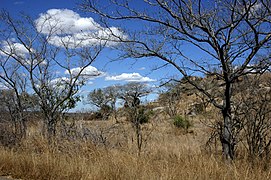

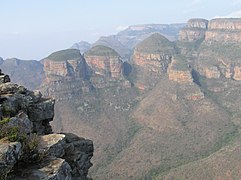
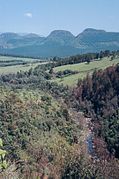

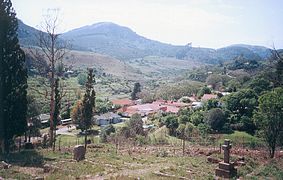
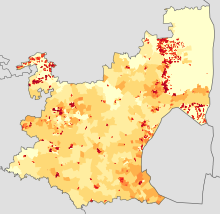

Comments
Post a Comment